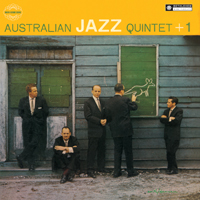Australian Jazz Quintet, and bands led by Michael Walker, Bruce Clarke, Jack Brokensha, Lindsay Copeland, Clare Bail, Eddie Oxley, Brian Brown, Mike Nock, review by John Clare

Album: 2 CDs, Australian Jazz Museum AJM 034. Rare Collectable Jazz
Artist: Australian Jazz Quintet, and bands led by Michael Walker, Bruce Clarke, Jack Brokensha, Lindsay Copeland, Clare Bail, Eddie Oxley, Brian Brown, Mike Nock
Release Date: 2016
Label: AJM
Jazz www.ajm.org.au Reviewed by John Clare, March 3rd, 2016
Curious and intriguing pages of modern jazz Down Under
There is at least one oddity regarding early Australian modern jazz. Historically it seems to be back to front. In America the first jazz called “modern” (Don Burrows once sensibly pointed out that all jazz was modern in its time) certainly carried less sentiment than the preceding swing, New Orleans jazz, Chicago jazz et al, but it was often delivered at speed with a fierce snap and incorporated polyrhythms or (cross-rhythms if you prefer) to disturb the air and create excitement and emotional release. We might think here of Dizzy Gillespie and Charlie Parker. The next major stage – West Coast or East Coast “cool’ if you prefer – incorporated some of the harmonic and rhythmic extensions but for all that presented a more understated expression and presence. We might think of Chet Baker, Paul Desmond, Gerry Mulligan and others.
Australian Jazz Quintet Early Australian modernism, for some reason, seemed to be inspired by the latter stage of American modernism – in jazz at any rate. Some of the first tracks on this interesting pair of discs are virtuosic but dynamically restrained. They are neat, fleet and perhaps excessively correct at first hearing. The very neatness and complexity can tend to imprison the music in another time yet on repeated hearing, a certain emotionalism seems to flow through the accomplished patterns. You can feel yourself within the minds and indeed the hearts of musicians in an expanding world with the Second World War still a receding shadow.
Something further should be noted: Australia certainly imitated American movements (whichever way round they reached us) but they also did so often enough in their own way. Unfortunately there is no example here of pianist and composer Donald Banks, who had forged a blend of jazz and classical music (he was a recognised classical composer) somewhat before most other “third stream” projects.(It seems there is another release from the Australian Jazz Museum – Don Banks, Early Australian Bebop Pianist & Composer (AJM 30).)
Bryce Rohde Quintet in Sydney, 1962, after Bryce of the AJQ returned to Australia.
Here is some news that might surprise you. The immaculate and very neat Australian Jazz Quintet – well featured here – went to America, and were joined by two Americans who came back here with them. That is not the news, however. This is: For a period they ranked with the Dave Brubeck Quartet as one of the two most popular jazz combos in the US. Incidentally, one of the Americans, bassist Ed Gaston, became an Australian. Most modern jazz fans in Sydney would have heard him many times at the El Rocco at Kings Cross. It is worth noting that it should have been Il Rocco. Why? El is Spanish. Il is Italian.The Australian Jazz Quintet tracks on the discs were recorded in Hollywood in 1956 and New York late 1957.
Music of more emotional potency and rhythmic excitement was recorded in America at this time, and in Australia at Jazz Centre 44 at St Kilda by the Brian Brown Quintet, whom I heard there every Sunday. Brown – not the actor – was an excellent writer of jazz tunes and a good and engaging but not exceptional tenor saxophonist; the two outstanding band members were the oldest – trumpeter Keith Hounslow and drummer Stewart Speer. Hownslow was virtually unschooled but capable of inspiring compositional improvisation, specially over Brown’s springing and exuberant writing and Speer’s airborne swing and contrasting hammered and hissing cross-rhythmic accents.
Brian Brown This is a little tricky to explain but in contrast to the earlier groups here more oxygen seems to circulate through the angles and joints of the music. In the attacks and strikes a certain amount of dust and debris falls through the air. In fact the music approached in vitalilty and excitement the bluesy emotionalism of certain Miles Davis combos of the time.
Finally we have a series of tracks from pianist/composer Mike Nock’s Three Out Trio. Many of us heard them regularly at El Rocco, which was always packed out. The intensity was overwhelming. Men shouted and one woman moaned somewhat disturbingly and quite regularly. Nock later played for twenty years at a high level in America and his drummer Chris Karan joined Dudley Moore’s trio in England, where I met up with him again and heard him often, sometimes at Ronnie Scott’s.
Incidentally, as the photos will show, few looked cool in those days (though the word was becoming bubonic or viral or something or other). Brian Brown’s younger players did. They wore Ivy League casual clothes. Damn it, so did I, working as I did in advertising as a layout artist. The odd thing about this latter music of Brown and co is that it was like the bluesier more galvanic modernism of hard bop, as it was called in America, yet it was played in a circular lighthouse-like building somewhat like a shrine to California cool. Beside Port Phillip Bay of course (where I went spear fishing).
Review originally published by the Music Trust














